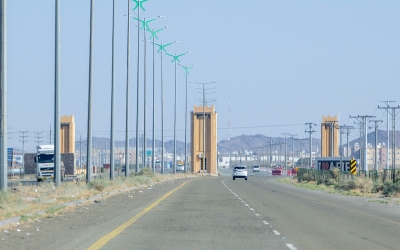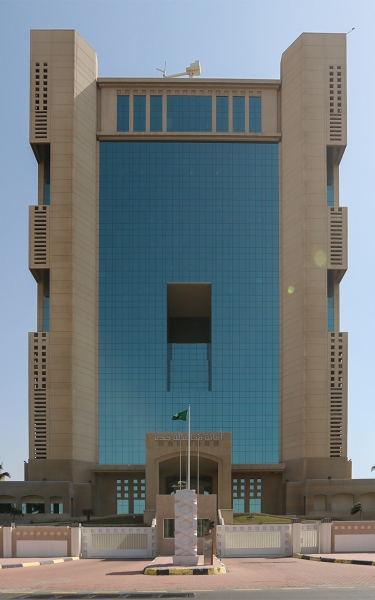
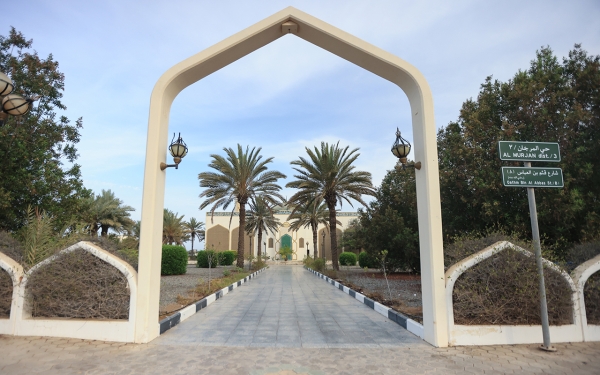
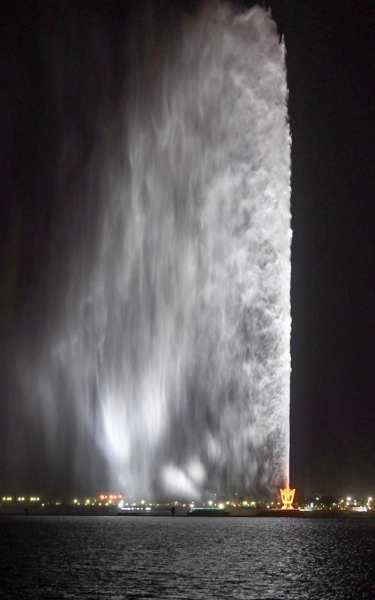
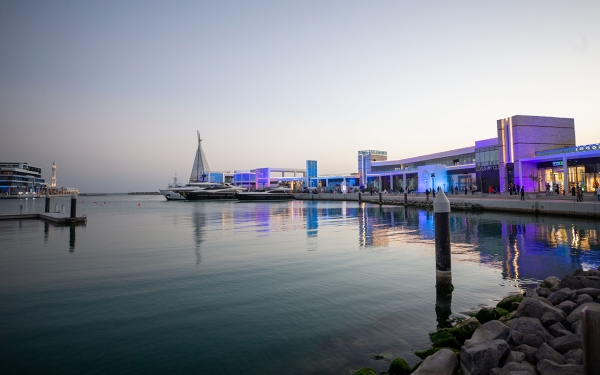
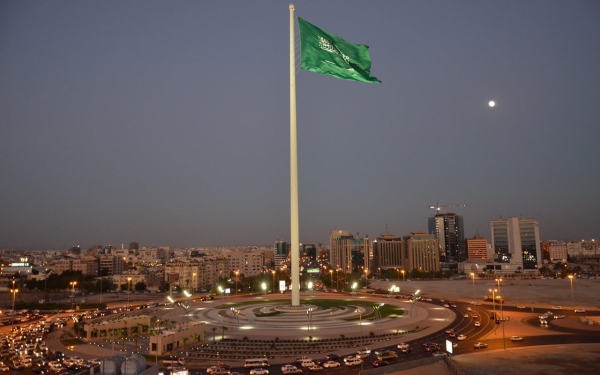
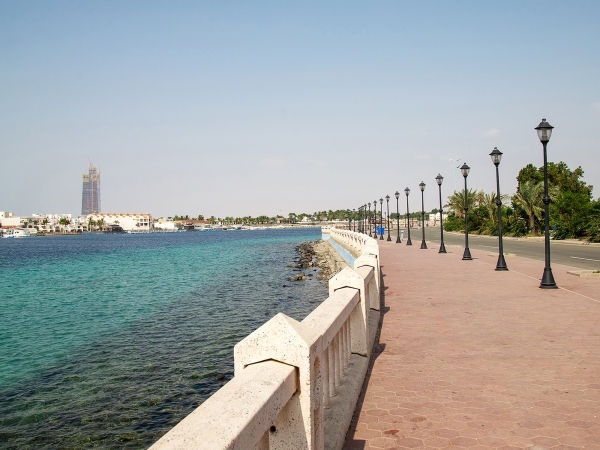
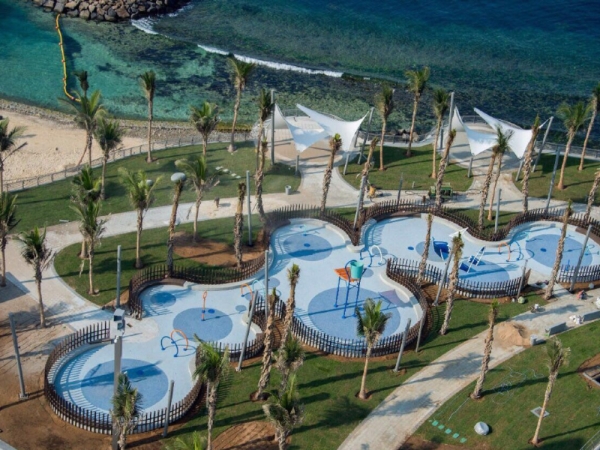
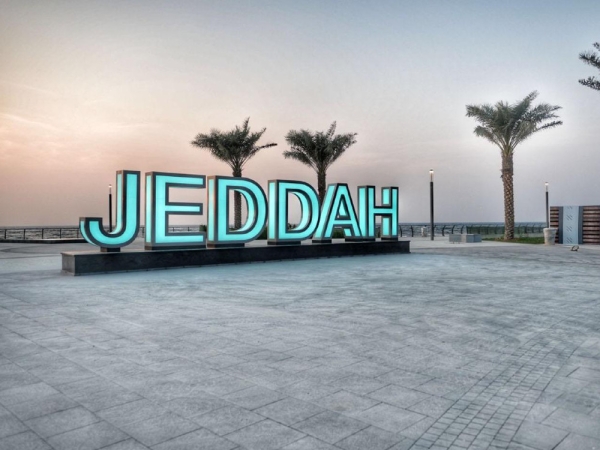
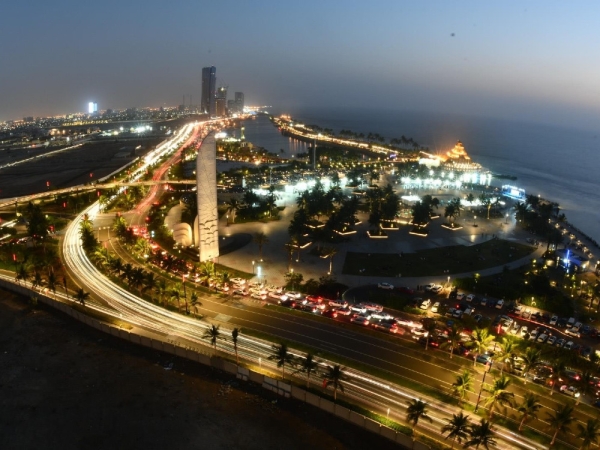
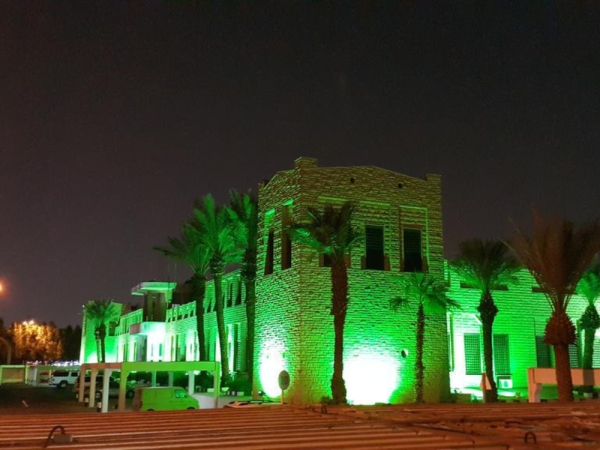
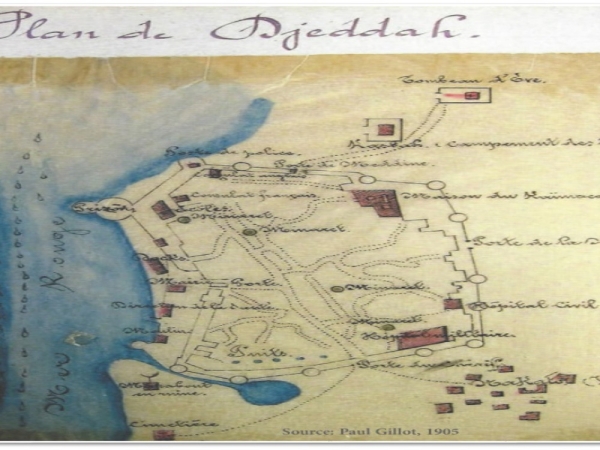
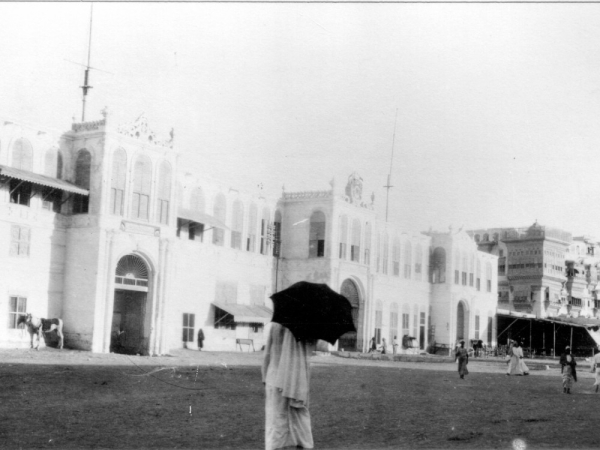
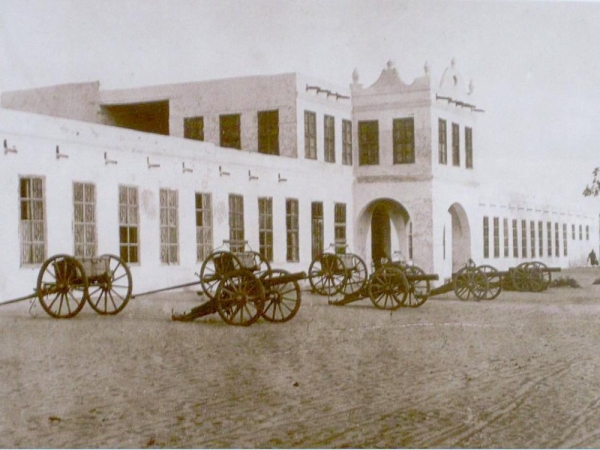
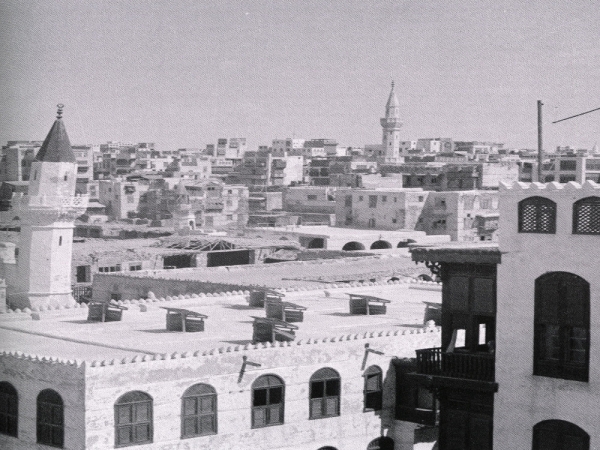
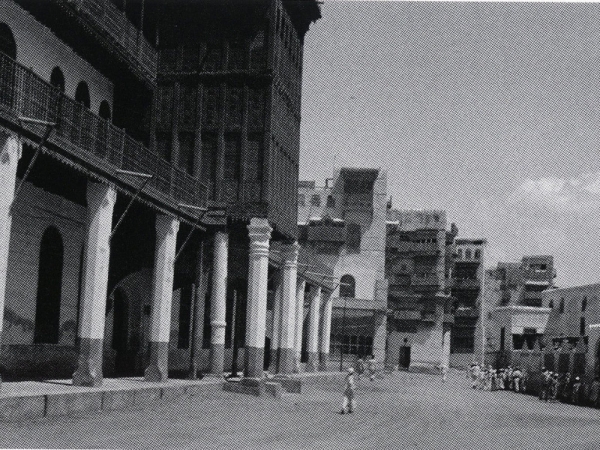
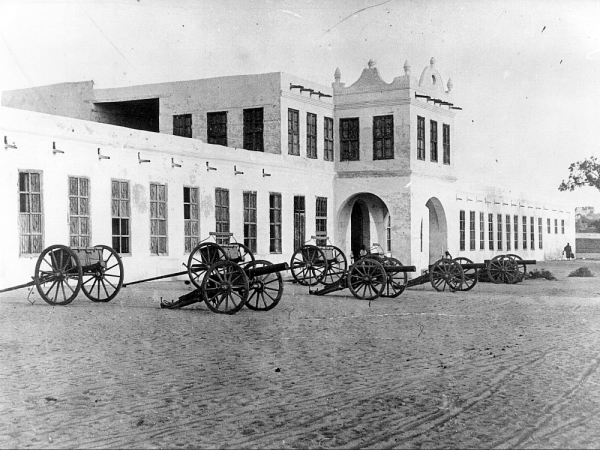
Jeddah City (romanized: Jiddah) is the center of the governorate of Jeddah. It is one of the administratively affiliated governorates with Makkah al-Mukarramah province in the Kingdom of Saudi Arabia. It is the second largest city in the Kingdom in terms of population and the first in Makkah al-Mukarramah province. It has a population of 3,751,722 persons. It is located in the central west of the Kingdom, along the Red Sea coast, at a distance of 947 km west of the capital, Riyadh, and eighty-nine km northwest of Makkah al-Mukarramah (headquarters of the emirate).
Significance of Jeddah city
Being a major logistical base in the Kingdom and a land, sea, and air transport hub, Jeddah is the main air entry point to the Grand Mosque in Makkah al-Mukarramah, the main destination in the life of more than one and a half billion Muslims all over the world.
Jeddah is the focal center of the biggest and fastest railway system in the Middle East thanks to having two stations for Haramain Railway which connects Makkah al-Mukarramah, Jeddah, and Madinah al-Munawwarah together. Its coast features Jeddah Islamic Port, the largest of the Kingdom's ports overlooking the Red Sea.
Jeddah is an attractive region for daily visits, as 55.62 percent of the province's residents can reach Jeddah by land within no more than one and a half hours, and 9.17 percent of the total population in the Kingdom can reach it within twenty minutes to an hour via the Haramain High-Speed Railway.
On the other hand, Jeddah is a cultural center and a tourist destination, as it has the Historic Jeddah, which is one of the UNESCO World Heritage Sites. This historic city preserves antique buildings and archaeological landmarks that represent the oldest living urban environment in the region since the beginning of the Islamic era up till now.
History of Jeddah city
Many historical accounts recount the beginning of human settlement in Jeddah city. Some historians referred to archaeological studies to determine that the first human settlement took place in the prehistoric eras, as supported by the unveiled archaeological monuments in Wadi Boweb northeast of the city.
According to the city's oldest historical documentation, Jeddah is a settlement that has existed since the prehistoric ages as the Thamudic inscriptions and monuments in Wadi Breman, east of Jeddah, have shown. Its distinguished location has drawn attention since ancient times as it was visited by Alexander the Great between 323 and 356 BCE.
Other historians date the establishment of Jeddah to around 3,000 years when it was a destination for fishermen after their fishing trip. The Quda'a tribe also settled there more than 2,500 years ago after the Marib Dam collapsed in 115 BCE. Some others consider that Jeddah's history goes back to before the rise of Alexander the Great.
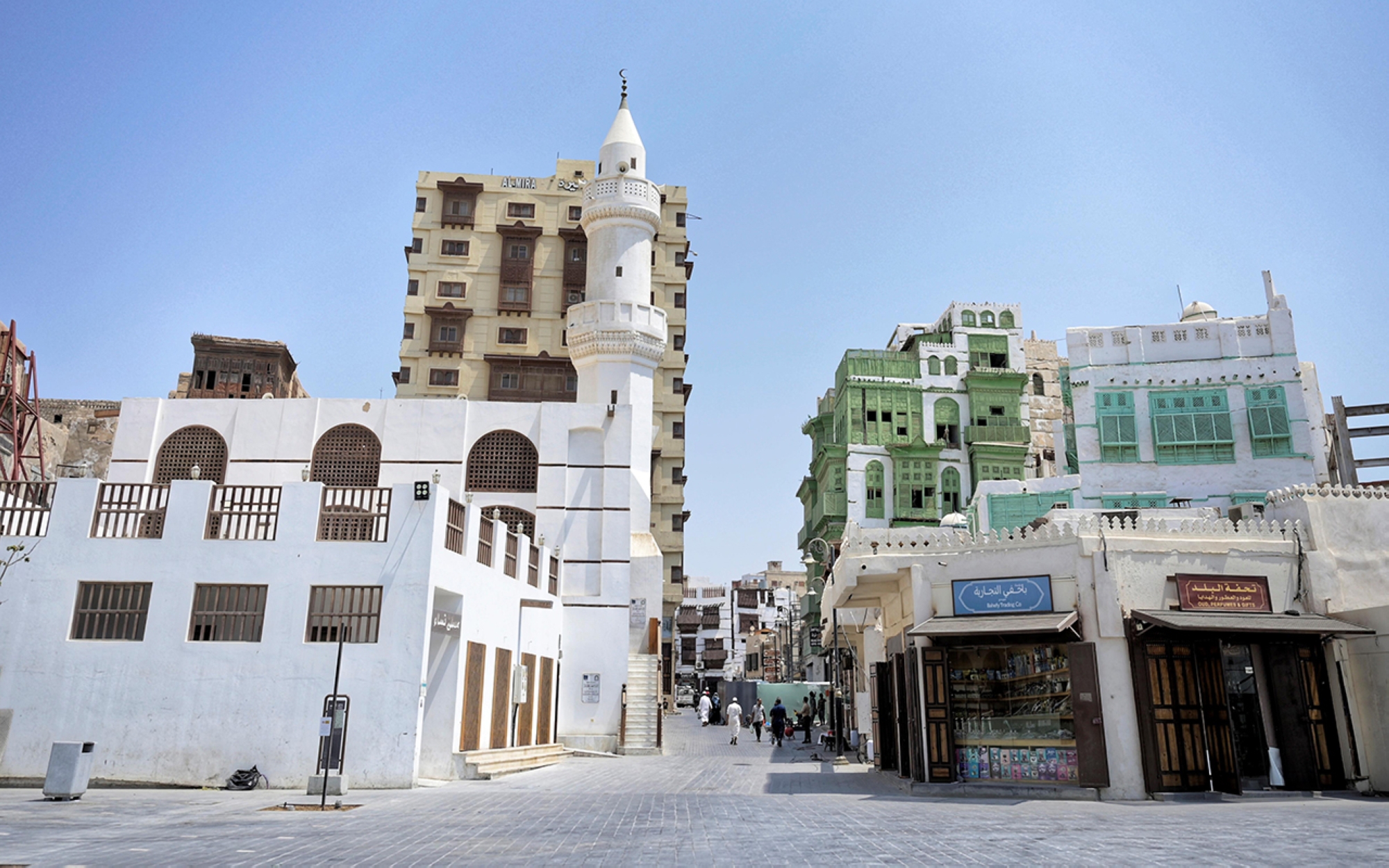
During the Islamic era, Jeddah was known to be the marine gate to the Two Holy Mosques. It rose in fame when the Rashidi Caliph, Uthman Bin Affan, selected Jeddah as the main port of entry and marine access point to Makkah al-Mukarramah in 647. Back then, it was called Balad al-Qanasel.
Jeddah during the Saudi era
Jeddah currently is one of the major Saudi cities. It is the main gate to the Grand Mosque in Makkah al-Mukarramah and the main destination in the life of more than one and a half billion Muslims all over the world. Jeddah is also a major logistical base in the Kingdom and a land, sea, and air transport hub. Since ancient times, it represented an external port for the Kingdom. It also forms a financial hub and a significant economic growth driver in the Kingdom. It also is a political and religious center, where it is the location of the Organization of Islamic Cooperation, the Islamic Development Bank, the International Islamic Fiqh Academy, and Jeddah Economic Forum.
Location of Jeddah city
Jeddah city is located on the western side of the Kingdom, amidst the Red Sea coast, and is one of the largest cities overlooking the sea. Known as the Red Sea Bride, it shares borders with four governorates as it is bordered by Rabigh in the north, Khulais and Al-Jumum in the west, and Makkah al-Mukarramah and Bahrah in the south. It also forms a plateau on the base of the Hejaz mountains. It is surrounded by Tihama plains to the east. Its location parallels coral reefs along its shores to the west.
Jeddah city demographics
Jeddah is administratively affiliated with Makkah al-Mukarramah province. It is classified as a vibrant and multicultural community. Its residents represent 46.8 percent of the population base in Makkah al-Mukarramah province, amounting to around 8,021,463 persons. Around 3,751,722 persons live in Jeddah. The 2022 Saudi census shows that Jeddah represents 11.6 percent of the Saudi population.
Designation of Jeddah
Concerning the designation of Jeddah, it was suggested that it could be pronounced as Juddah (with a Dammah diacritic on the Jim) or Jiddah (with a Kasrah diacritic on the Jim), signifying the seashore in Arabic. However, an intellectual school suggested referring to it as Jeddah (with a fatha diacritic on the Jim), which translates to the grandmother, representing the maternal grandmother, in reference to our mother, Eve, who might have been buried there. It has also been said that it was named after one of the members of the Quda'a tribe, descendants of the ninth grandfather of Allah's Prophet, Mohammed (PBUH), as they lived in Jeddah more than 2,500 years ago.
Climate in Jeddah city
The climate in Jeddah city is known for its high temperature and humidity in summer, where temperatures could reach up to forty degrees Celsius, as it is located within an extension of an atmospheric depression generated by a hot and solid air mass. Humidity reaches higher levels in summer due to the rise in seawater temperature. It decreases in winter due to the influence of the moderate air mass associated with the anticyclone.
Light rain falls on Jeddah city. Rain, which usually falls in winter, spring, and fall, is accompanied by thunderstorms. This is due to the anticyclones occurring from the west to the east and meeting with the extension of the Sudan atmospheric depression upon the region.
As it is located on the Red Sea shore, the predominant winds rising in the area are northwestern winds. They are often light to moderate winds throughout the year. However, during winter and spring, southern winds rise accompanied by temperature rise. Winds become strong and burst at speed, causing sandstorms. They might even be accompanied by thunderstorms and rainfall.
Transportation in Jeddah city
Jeddah has two stations for Haramain Railway, one of the largest and fastest railway systems in the Middle East. It connects Makkah al-Mukarramah, Jeddah, and al-Madinah al-Munawwarah: the first is located in King Abdulaziz International Airport and the second is Sulaymaniyah Central Station. In addition, the Ministry of Transport and Logistic Services intends to execute a new railway project that is going to transport goods and passengers by connecting Jeddah and Riyadh over a distance of 950 km. Moreover, Jeddah contains King Abdulaziz International Airport, the biggest airport in the Kingdom, and the headquarters of Saudi Arabian Airlines. It also has the largest passenger terminal in the world.
Located on its coast, Jeddah Islamic Port is the Kingdom's largest port on the Red Sea and the base of maritime navigation between Asia and Europe. It contributes 31 percent of the total freight traffic in the Kingdom and transports 24 percent of the total passengers via Saudi ports. The Haramain highway has recorded the highest traffic rate in the Kingdom, with an average of 2.7 million trips monthly.
King Abdulaziz International Airport
King Abdulaziz International Airport was inaugurated in Jeddah in 1981. It is considered to be the gate to the Two Holy Mosques and the main entry point from the west of the Kingdom. It is the first international airport project in the Kingdom. It is deemed the headquarters and operations center for the Saudi Arabian Airlines. The airport also has the fourth-largest passenger terminal in the world: the Pilgrims Hall.
Due to the vastness of its facilities and the enormity of its capacity, the airport is an advanced economic hub and a major cultural monument of the Kingdom and the region. It is also integrated within the aspiring development plans of the Kingdom. It achieves the plans of the General Authority of Civil Aviation for enhancing the position of Jeddah city as a global hub. King Abdulaziz International Airport in Jeddah has become one of the busiest airports in the Middle East and the Gulf in terms of international and domestic air traffic, thus being dubbed as one of the most important airports in the Middle East. It is connected with the global airport network. Moreover, in 2018, it ranked first among Saudi airports in terms of passenger traffic, when the number of travelers through the airport reached 35.8 million passengers.
The estimated area of the airport is around 105 km. It includes six large travel lounges. The airport is equipped with an integrated infrastructure and comprehensive services including 220 platforms for passenger service, eighty self-service devices, and sixty-three passport platforms. Ninety-eight planes can simultaneously land at the airport, and its new parking has a capacity of 21,665 cars.
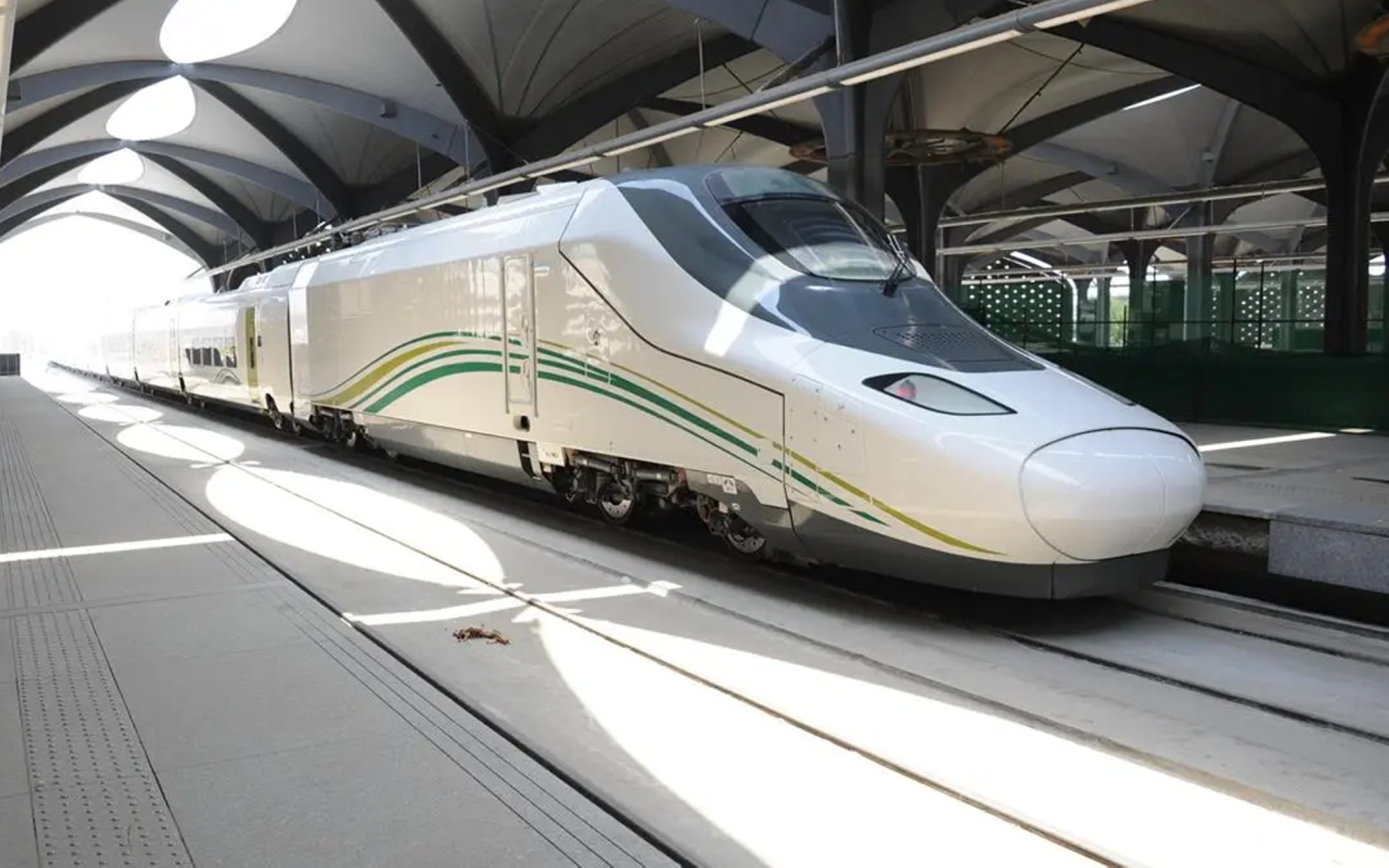
Haramain High Speed Railway
It is one of the high-speed transportation projects of the Kingdom. It was built to serve Hajj and Umrah performers and facilitate their transportation between Makkah al-Mukarramah and al-Madinah al-Munawwarah. In 2018, the Custodian of the Two Holy Mosques King Salman Bin Abdulaziz Al Saud inaugurated the project when he took the first train trip from the city of Jeddah's Sulaymaniyah Station to al-Madinah al-Munawwarah, announcing the official operation of the Haramain High Speed Railway trips.
The train connects the cities of Makkah al-Mukarramah and al-Madinah al-Munawwarah. It passes through Jeddah city and King Abdullah Economic City in Rabigh. It is an electric train covering a distance of 450 km. It is powered by overhead lines and can travel at a distance of three hundred km per hour. Its construction began in 2009, funded by the Public Investment Fund (PIF) and in partnership with the private sector. Construction costs amounted to SAR60 billion. Its first commercial trip took place in 2018, while the train made its first passenger trip in 2019. The Haramain High Speed Railway consists of thirty-five trains, each with thirteen coaches and 417 seats. The train has a daily capacity of 160,000 passengers and an annual capacity of sixty million passengers.
Jeddah Islamic Port
Jeddah Islamic Port is the main import and export port of the Kingdom and the first port among all the ports of the Red Sea. Its significance stems from being a gateway that welcomes Hajj and Umrah performers annually. It is also a fundamental access point in the Red Sea for re-exportation since 75 percent of maritime trade and transshipment going through Saudi ports take place in this port.
The port also holds historical significance, as it was founded during the reign of Caliph Uthman Ibn Affan in the year 647. The founding King Abdulaziz Bin Abdulrahman Al Saud has dedicated special interest to this port, and his descendant kings followed on the same development path.
It spans 12.5 km and is, thus, the largest Saudi port on the Red Sea coast in terms of its covered area, and the third among Saudi ports in terms of capacity. The port receives more than five thousand cargo ships annually, travelling between Asia and Europe, and is considered as a connecting point between both continents.
Jeddah Port is known for its marine control tower that distinguishes the coast of Jeddah from all others on the Red Sea. The control tower has become one of the city’s landmarks. It is equipped with an advanced Ship Traffic Management System to serve and monitor the maritime movement in shipment lanes and harbor basins.
Education in Jeddah city
The total number of general public and private education students in Jeddah governorate amounts to around 696,878 male and female students. They are enrolled in 2,717 public and private schools. The most recent 2022 statistics of the Directorate of Education in Jeddah show that Jeddah is one of the leading cities in terms of academic education in the Kingdom. It hosts three public universities.
General education in Jeddah city
The first school was established in Jeddah in Hejaz, before the unification of the Kingdom. It was named al-Falah school and was established in 1905. It contributed to spreading culture and instilling knowledge among individuals by teaching Arabic and Islamic education, among other sciences and knowledge.
Ever since, general education has expanded in Jeddah city. The total number of public schools reached 1,342 schools in which around 528,548 male and female students are enrolled. The total number of private and international schools is around 974 schools in which around 112,599 male and female students are enrolled across all education stages, as shown by the latest 2022 statistics of the Directorate of Education in Jeddah.
Higher education in Jeddah city
Jeddah includes three public universities: King Abdulaziz University, established in 1967, the first Arab university and the fifty-first university worldwide, among the top 1,500 universities, according to U.S. NEWS ranking; King Abdullah University of Science and Technology, established in 2009; and the University of Jeddah, the most recent university of the Kingdom, established in 2014.
The number of students enrolled in public colleges and universities in Jeddah is around 103 thousand students, according to the most recent university statistics. The governorate has several private universities and colleges specialized in several fields, e.g., business and technology, health sciences, and management.
Research centers
Jeddah is home to many institutes and think tanks that enrich the scientific research movement in the Kingdom in several areas, including medicine, technology, engineering, and humanities. These think tanks include the University of Jeddah Center for Research and Product Development, King Fahd Medical Research Center, Advanced Membranes and Porous Materials Center, the Clean Combustion Research Center, Computational Bioscience Research Center, Supercomputing Center, Chemical Catalysis Center, Solar Energy and Photovoltaic Engineering Center, Red Sea Research Center, Desert Agriculture Center, Visual Computing Center, Water Desalination and Reuse Center, Research and Consulting Institute of King Abdulaziz University.
Libraries
Jeddah city has many public and private libraries that enrich the educational and research movement, most notably: the Central Library of King Abdulaziz University, and the King Fahd Public Library in Jeddah. This library includes several sections: Main Library, Reference Library, Youth Library, Children Library, Women Library, Sighted Hearts Library, and the Multimedia Library.
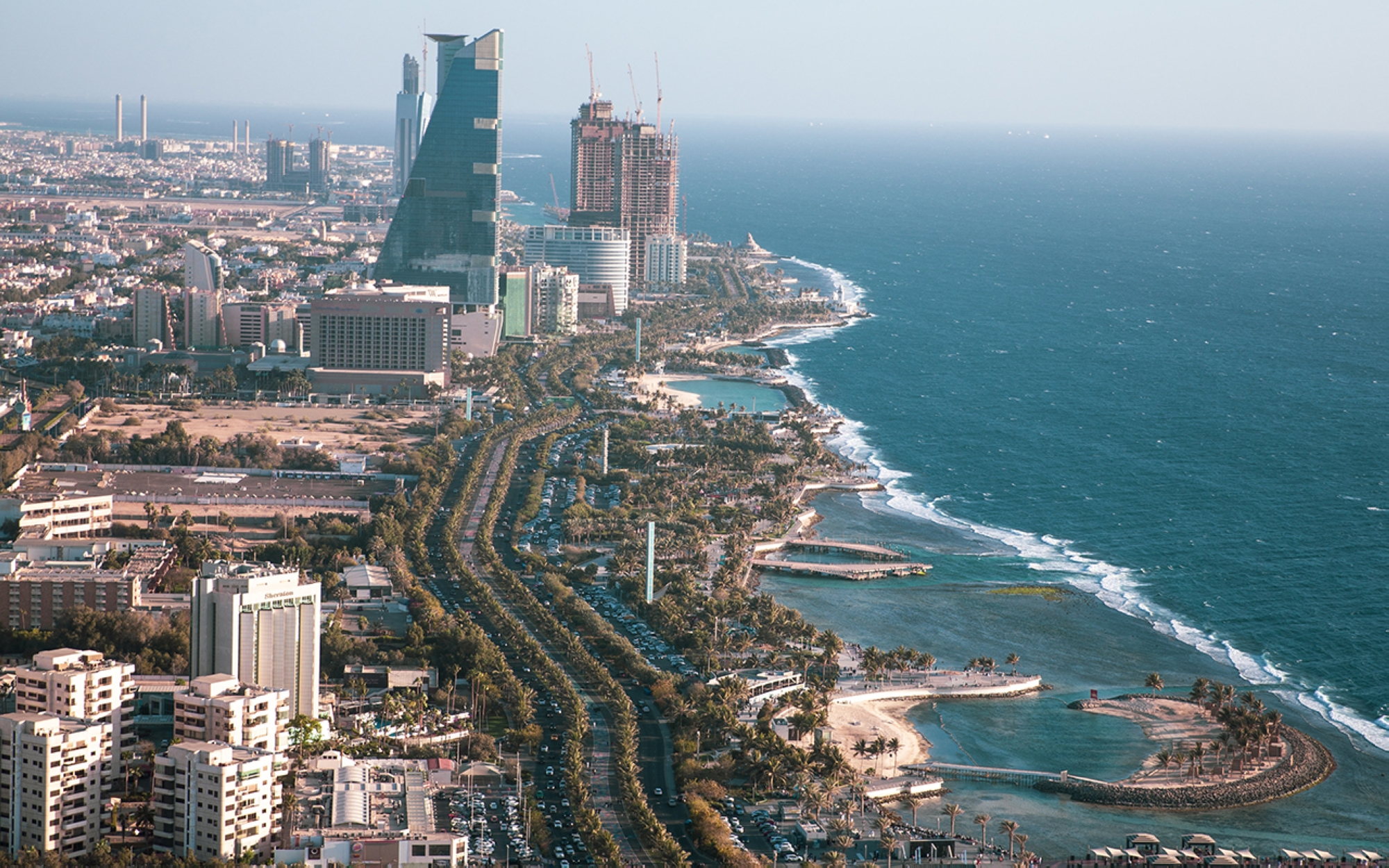
Development Projects in Jeddah city
Jeddah city encompasses many development projects aimed at the development of the city and its transformation into a leading tourist destination. The most notable projects include:
Jeddah Central Development Project
Jeddah Central Development Project is one of the megaprojects announced in 2017 as part of the Public Investment Fund's projects. It is one of the projects aimed to revitalize the waterfront area in the center of Jeddah's Corniche, transforming it into a vibrant tourist, residential, and commercial destination to rank Jeddah among the top hundred cities in the world.
In 2021, His Royal Highness Prince Mohammed Bin Salman Bin Abdulaziz, Crown Prince, Prime Minister, Chairman of the Board of Directors of the Public Investment Fund, and Chairman of the Board of Directors of Jeddah Central Development Company, launched the master plan and main pillars of the Jeddah Central Development project (formerly known as New Jeddah Downtown), with investments amounting in total to SAR75 billion and allocated for the development of 5.7 million m, of which 42 percent represent residential units and 35 percent represent entertaining areas. The project encompasses four main global landmarks: an opera house, a museum, a sports stadium, surrounding ponds, and coral farms, in addition to ten quality entertainment and tourism projects, seventeen thousand residential units, a world-class dock, beach resorts, and a wide range of local and international luxurious hotels, restaurants, and cafés, among various shopping options.
Jeddah Historical Rejuvenation Project
The project was launched in 2021 by Prince Mohammed Bin Salman to transform historic Jeddah into a hub that attracts cultural and business projects, a primary destination for entrepreneurs from around the world, and an integrated region that stimulates the economy and contributes to the growth of the local GDP.
The work on the Jeddah Historical Rejuvenation Project progresses along various paths, including infrastructure and services, strengthening urban aspects, improving the quality of life and increasing its efficiency, and developing and preparing the environmental and natural space. The project is a significant part of the Historic Jeddah Development Program, aiming to invest in history, cultural, urban, and economic elements to contribute to the growth of the local GDP and achieve the targets of Saudi Vision 2030.
The project seeks to highlight the historical features of Jeddah, including thirty-six historical mosques, more than six hundred heritage buildings, and five major historical markets, as well as courtyards, passageways, and sites of important historical significance.
Development of waterfronts
The 4,500 m waterfront extends from al-Nawras Roundabout, north of Jeddah, to Jabir Bin al-Harith Street. Jeddah Waterfront's total area is about 730 thousand m². It can accommodate 120 thousand visitors at once. Green areas occupy more than 275 thousand m². In addition, it includes beaches for swimming big enough for 10 thousand persons and equipped with breakwaters and five watchtowers.
Jeddah Municipality is developing the waterfront. The work began on the fourth and fifth stages of the development in 2017, at a total cost of SAR800 million. Moreover, the waterfront contains destinations and features that have been established there for the first time in Jeddah, such as the hanging walkway, which is equipped with the necessary services to welcome its visitors.
The waterfront is a recreational tourist zone located on Jeddah Corniche that overlooks the Red Sea. The waterfront takes the seagull, which is quite common on Jeddah's shores, as its logo. The waterfront is also home to al-Nawras Island project, located on the northern Corniche of Jeddah with a length of one thousand m, a width ranging between thirty and seventy m, and a total area of about 52,240 m². Moreover, it contains a variety of restaurants, cafes, a marina for boats, cinemas, a women’s beach, a spa, and a one km long walkway with a width of twenty-five m.
Urban heritage in Jeddah city
Jeddah hosts many urban heritage monuments that are iconic to the city, most notably:
Historic Jeddah
Historic Jeddah is a central archaeological, commercial, and tourist area. It consists of the Jeddah neighborhoods within the old wall of the city, gates, houses, markets, buildings, monuments, public squares, personal museums, and ancient mosques. Historic Jeddah is one of the Saudi archaeological sites listed in the United Nations Educational, Scientific and Cultural Organization (UNESCO)’s World Heritage List.
Historic Jeddah appeared as a locale for fishermen after their fishing trips across the Red Sea. Over time, Jeddah burgeoned into a human settlement where trade, fishing, construction, and a variety of handicrafts flourished at the hands of various ethnic groups.
Historic Jeddah contains around four hundred buildings, the oldest of which dates back to the tenth century, and the most recent to the twentieth century. Most of these buildings were built according to the architectural style prevalent in the Red Sea basin, which relies on sea clay and prospected stone, wood for doors and windows, and separate Rawashin with brown, green, and blue paint, reflecting the economic status of the owner. Many of these buildings survived till today as a distinguished symbol of the city's monuments and houses.
Historic Jeddah is surrounded by a wall that was first built in the fifteenth century, featuring eight gates (babs), namely: Bab al-Madinah; Bab Makkah; Bab Shareef; Bab al-Maghariba; Bah Jadeed; Bab al-Nafe'a; Bab Suraif; and Bab al-Sabbah. Within it, Historic Jeddah was divided into four main neighborhoods (Harat): Harat al-Sham, Harat al-Yemen, Harat al-Mazloum, and Harat al-Bahr.
Palaces of Historic Jeddah
Jeddah city is home to landmarks that influenced modern Saudi history, most notably: Bait Nassif in which the founding King Abdulaziz Bin Abdulrahman Al Saud resided in 1925 and for about ten years, as well as Khuzam Palace, one of the royal historical palaces whose construction was commissioned by King Abdulaziz to become a royal residence and a center for managing the affairs of the Kingdom's citizens. It is located in downtown Jeddah and is one of the first buildings ever built with cement and steel in the Kingdom. Currently, the palace is one of the most prominent tourist landmarks in Jeddah city.
Mosques of Historic Jeddah
Jeddah city includes very ancient historic mosques that reflect the Hijazi and Islamic architecture style, including al-Shafei mosque, which was built during the reign of Caliph Umar Bin al-Khattab. The mosque is characterized by its unique Islamic architecture, its ventilated yard, and its square shape. It underwent many restorations in various eras, and the Custodian of the Two Holy Mosques King Salman Bin Abdulaziz Al Saud dedicated special attention to it, following up on the different stages of its development in 2014 (when he was Crown Prince), in his visit to Historic Jeddah. Restoration works were completed and the mosque was reopened in June 2015.
Al-Maamar mosque is one of the oldest historic mosques in Jeddah city. It was built around 340 years ago, in 1847, and was renovated and restored in 1867. Historic Jeddah is house to several historic and monumental mosques, including Uthman Bin Affan mosque, which was built between the fifteenth and sixteenth centuries, also known as al-Abanous (Ebony) Mosque, due to the presence of two flagstaff made of ebony, al-Basha mosque, and Akkash mosque, built in 1786, in addition to al-Hanafi mosque, built in 1902.
Tourism in Jeddah city
Jeddah is considered a cultural center and tourist destination. It includes the historical part which still preserves heritage buildings, monuments, and neighborhoods reflecting the social and economic aspects of traditional life. The biggest part of the most prominent parks in Jeddah is connected to the waterfronts. They are known nationwide as a center of coastal development and marine activities in the Kingdom. Jeddah includes five waterfronts, which are the most visited destinations in Jeddah.
Jeddah Season
Since 2019, Jeddah city has celebrated Jeddah Season, launched as part of the Saudi Seasons initiatives. It features artistic, musical, cultural, entertainment, and sports events in many regions, including five areas of the city, in addition to an area specifically created for the season. Jeddah Season 2019 events, held from July 08 to July 29, focused on five areas within the city: Historic Jeddah (al-Balad), al-Hamra Corniche, the Waterfront, King Abdullah Sports City, and Abhur, in addition to holding other events around Jeddah and in King Abdullah Economic City.
In the second edition, launched in May 2022, the season's events were held in the five previous areas, located in the city, in addition to the creation of nine new areas specifically for the season's events, including: City Walk, which is the largest area of the season at 282 thousand m. It contained nine sub-areas, such as Anime Village, Adventure Village, Fashion Village, barbecue area, and the Arab and international Studios Area.
The areas of Jeddah Season 2022 also included Jeddah Art Promenade, Prince Majed Garden, in addition to Jeddah Pier, a mobile amusement park featuring thirty-nine games, as well as the Colored Garden, Adrenaland, and the Jeddah Jungle with its garden that houses over one thousand animals, and allows its visitors to watch them up close. Moreover, Jeddah Season 2022 offered safari adventures and jungle walks.
Created areas also include Jeddah Yacht club, which offers an entertainment experience including diving trips, fishing, parasailing, and amphibious cars. Moreover, Jeddah Superdome, the world's largest pillarless dome, hosted music parties and several festivals.
Jeddah Season 2022 has set a record in terms of the number of visitors, which amounted to six million visitors from the Kingdom and abroad, where the number of tourists has surpassed one million from 129 countries around the world. The season has also contributed to diversifying the opportunities and partnerships it created in the private sector, in addition to contributing to the creation of new job opportunities which amounted to seventy-six thousand direct and indirect jobs, as the number of jobs surpassed 80 percent of the total number of Saudi workers during the event.
Historic Jeddah Festival
Historic Region covers a vital area for holding festivals, occasions, and annual cultural and entertaining activities, and for hosting tourist groups. It also hosts the Historic Jeddah Festival annually. It is the first festival hosted in Jeddah, and it joins both heritage and culture. It is visited by more than half a million visitors yearly. It was first launched on January 16, 2014. It is held for fostering the position of the Kingdom as a source of Arab and Islamic culture, literature, and history, introducing the history, customs, and heritage of this region to the new generation, recounting the tales of the past and its link with the present, and granting visitors the opportunity to connect with the history of the past century and celebrate a heritage that is more than three thousand years old.
Jeddah touristic sites
Jeddah includes facilities and locations for performing arts, and areas for walking that welcome their visitors, including five waterfronts: Roshn Waterfront, the Northern Corniche, the Central Corniche, Dhahban Park, and Alsaif Beach. These waterfronts are among the most visited sites in the city, and a part of them is allocated for holding music concerts.
Jeddah has many heritage and urban landmarks that represent icons of the city, most notably: Jeddah Light in Jeddah Islamic Port that overlooks the Red Sea coast and is designed in a high-tech architecture style and equipped with a Vessel Traffic Monitoring and Information System (VTMIS). It also has King Fahd's Fountain on the Red Sea coast which is the tallest fountain of its kind in the world, the historic Khuzam Tower which functioned as the city's water distribution network for almost four decades, and the Saudi flagstaff that is the tallest flagstaff in the world standing at the height of 171 m.
Cultural life in Jeddah city
There are many cultural monuments that reflect the significance of Jeddah city as an outstanding cultural icon, starting from the urban pattern that translates its unique heritage and civilization and up to its influential role in highlighting and developing the cultural movement. In fact, it is home to the first literary club of the Kingdom and it is where the second International Book Fair of the Kingdom is held.
Jeddah Literary Cultural Club
Jeddah Literary Cultural Club was established in 1975. It is the first literary club in the Kingdom. It has been established to serve as a location for gathering intellectuals and authors in Jeddah. Throughout its journey, the Jeddah Literary Cultural Club made several achievements, most notably: Hiwar Group Forum to discuss issues related to literature and ideas, such as the discourse of critical and creative enlightenment, and the discourse of local narration, in addition to the Text Reading Forum, which discusses the most prominent issues and developments in the literary field. The club was also concerned with publishing and issuing dozens of books in the fields of poetry, stories, and novels, as well as a number of various periodicals.
Jeddah International Book Fair
It is a recent exhibition in comparison with the history of international book fairs in the Arab world and the Arab States of the Gulf. It is the second international book fair held in the Kingdom after the Riyadh International Book Fair. Its first edition was held in 2015. It attracts around half a million visitors and usually features around one hundred events, including: the Creative Translation Contest, which grants Saudi translators the Creative Translator Medal, and the Cultural Cafe, which holds dialogue panels and cultural gatherings with Arab writers, authors, and critics. The fair also explores arts, where it has dedicated a section for art exhibitions. Moreover, it includes an independent pavilion for Saudi writers and a pavilion for children. It hosted sixty workshops and organized autograph ceremonies for two hundred male and female writers.
Museums in Jeddah city
Jeddah city is house to several museums that recount the history of the city and celebrate its heritage. It hosts the Jeddah Museum, located in the palace of the Founding King Abdulaziz Bin Abdulrahman Al Saud, also known as Khuzam Palace, and which reflects the cultural and historical aspects of the Kingdom. The city is also the location of al-Taybat museum that displays, in its multiple floors, artifacts exhibited in a multi-room complex reflecting the architectural style of the ancient city. Jeddah also hosts a different type of museum, known as the open museum. It displays the world's largest set of sculptures and models and displays art sculptures made by major global visual artists, most notably Henry Moore, a famous British artist, and French artists Victor Vasarely and Cesar Baldaccini.
In 2023, the Islamic Arts Biennale Museum was held under the title "The First House" at the famous Hajj Hall of King Abdulaziz International Airport in Jeddah. The Biennale reflects the close relationship between art and faith, where it was held around two main themes: Qibla and Hegira. The exhibition aims to revive various forms of the cultural, intellectual, and artistic life that remain inspired and rooted within the Awwal Bayt (first house) of people.
Sports in Jeddah city
Jeddah city has many stadiums dedicated to various sports. King Abdullah International Stadium is one of the most notable sports facilities in the city. Moreover, Jeddah has hosted Formula 1 races in the Jeddah Formula 1 circuit which ranked first in terms of speed and number of turns. Furthermore, Jeddah is also house to the oldest and most popular clubs of the Kingdom, being al-Ahli Club and al-Ittihad Club.
Sports facilities in Jeddah city
Jeddah city has many sports facilities, and King Abdullah Sports City is one of the fifty largest sports facilities worldwide. It is designed according to FIFA standards and has a capacity of sixty thousand spectators. It is also house to King Abdullah International Stadium (or the Shining Jewel), one of the world's fifty largest sports stadiums and the second largest stadium in the Arab world. In 2019, the stadium hosted a game of the Italian Super Cub, one of the most notable sports and global events, for the first time. It was attended by sixty-one thousand spectators. The stadium also hosted a game of the Spanish Super Cup in 2020. Jeddah is also house to Prince Abdullah Al-Faisal Stadium, which was established in the 1970s. The stadium hosts local and international games, covers an area of eighty-four thousand m, and has a capacity of twenty-three thousand spectators.
King Abdullah Economic City is house to the Royal Greens Golf Course, one of the gulf clubs in the Kingdom. It also includes an academy for teaching gulf and features a training area. It also hosts the Saudi International Gulf Professionals Tournament.
Formula 1 race in Jeddah city
The Saudi Arabian Grand Prix is one of the most famous Formula 1 races held in Jeddah, ever since the tournament was held for the first time in 2021. The event is held on a circuit that ranked first worldwide in terms of speed and number of turns, amounting to twenty-seven turns, including sixteen turns to the left and eleven turns to the right. This enables drivers to reach a speed of up to 250 km/h. The circuit was designed in collaboration between Hermann Tilke, a German designer from Tilke Engineers & Architects, and the automobile sport team, resulting in the world's longest circuit extending along 6.174 km.
Sports clubs in Jeddah
Two of the oldest and most popular Saudi clubs in the Kingdom are headquartered in Jeddah city: al-Ahli Club and al-Ittihad Club, both part of the eighteen clubs participating in the Saudi Pro League.
Entities headquartered in Jeddah city
Jeddah city is a political, religious, and economic center that hosts the headquarters of many organizations and entities, most notably:
Organization of Islamic Cooperation.
Islamic Development Bank.
International Islamic Fiqh Academy.
Jeddah Economic Forum.
Union of OIC News Agencies.
Saudi Geological Survey.
Saudi Arabian Airlines Headquarters.
Saudi National Bank Headquarters.
King Abdullah Airbase.
King Abdullah Sports City.
King Abdullah Economic City.
Related quizzes
Related articles


